Unlike some countries, the United Kingdom (UK) does not have a comprehensive system of recording migrants, particularly those leaving the country, nor any legal requirement to notify change of address. Therefore, migration is the most difficult component of population change to measure and project. Migration and the reasons for migrating are also much more susceptible to short-term changes in social and economic circumstances than births and deaths. More detailed information on the methodology for estimating migration is available within the Migration section of the National Records of Scotland (NRS) website.
Historically, Scotland has been a country of net out-migration, with more people leaving to live elsewhere than moving to live in Scotland. However, since the 1960s, net outmigration has greatly reduced and, in some years during the late 1980s and early 1990s, Scotland experienced net migration gains. As Figure 5.1 shows, Scotland has now entered a period of net in-migration. From the year to mid-2004 until the year to mid-2011 there were net gains of at least 18,600 per year and in the year to mid-2007 the net migration gain was 33,000, the highest since these estimates started in 1951. However, in the last two years net migration has fallen and was only 10,000 in the year to mid-2013 compared with 30,200 in the year to mid-2011.
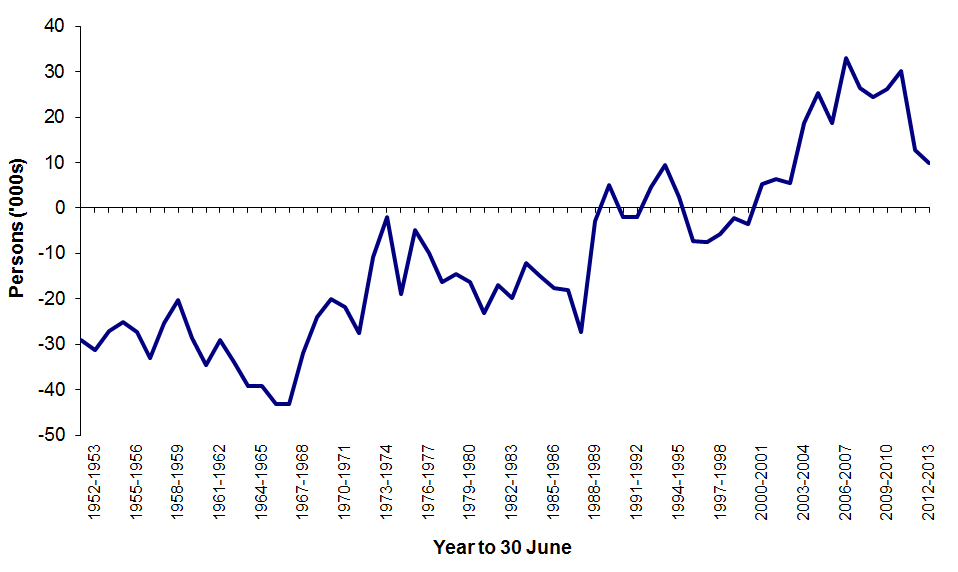
Net migration is the difference between much larger flows of migrants into and out of Scotland. The level of net migration can be significantly affected by relatively small changes in these gross flows from year-to-year, particularly if one flow rises while the other falls. In the last ten years, migration to Scotland has typically been about 90,000 per year whilst migration from Scotland has been around 70,000. In the last three years migration to Scotland has fallen by, on average, 5,500 per year to about 76,000. Migration from Scotland has fluctuated over the same period with a decrease of approximately 9,000 in the year to mid-2011, an increase of approximately 11,000 in the year to mid-2012 and a decrease of approximately 2,000 in the year to mid-2013.
In the year to 30 June 2013, around 47,700 people came to Scotland from England, Wales and Northern Ireland and around 39,800 people left Scotland for the rest of the UK. The net gain of around 7,900 represents an increase of 4,900 on the net gain of the previous year.
During the same period, about 28,200 people came to Scotland from overseas and around 26,100 left Scotland to go overseas, giving a net migration gain from overseas of around 2,100. This is lower than the net migration gain from overseas in previous years, due to fewer people coming to Scotland from overseas than in previous years and because more people left Scotland than in previous years. Estimating international migration is particularly difficult as the estimate is based primarily on the International Passenger Survey (IPS). This is a sample survey conducted at main airports and ports across the UK, and the sample size for Scotland is very small (around 250 migrant contacts in the year to mid-2013). Internationally, migrants are defined as people who change their country of usual residence for 12 months or more. So short-term seasonal migrant workers, including many people from the Eastern European states which joined the European Union (EU) in 2004, will not be included in these migration estimates.
Figure 5.2 illustrates the trend in flows of people to and from the rest of the UK since 1981. In the last two years there has been an increase in people coming to Scotland from the rest of the UK following small drops in the previous three years. In the year to mid-2013 it was estimated that 47,700 people came to Scotland from the rest of the UK; the recent peak of 61,900 was recorded in the year to mid-2004. There was also a decrease in outward migration to 39,800 in the year to mid-2013 from the previous year's figure of 42,100.
Figure 5.3 shows the trends in flows of people to and from overseas since 1991. In- migration from overseas has been increasing since 2003 but has dropped in the last three years with decreases of approximately 8,000 estimated in the years to mid-2012 and mid-2013. For the three years between mid-2008 and mid-2011 out-migration to overseas decreased by an average of approximately 4,500 per year. Decreases of 5,500 and 7,700 were estimated in the years to mid-2009 and mid-2011, respectively, and a smaller decrease of 200 was estimated in the year to mid-2010. However, in the year to mid-2012 out-migration to overseas increased by 9,300 to 26,200. This level of out-migration was maintained in the year to mid-2013 with out-migration to overseas dropping only slightly to 26,100. The figures shown here are from the Long-Term International Migration (LTIM) series produced by the Office for National Statistics (ONS) and the National Records of Scotland revised international migration estimates for mid-2001 to mid-2011.
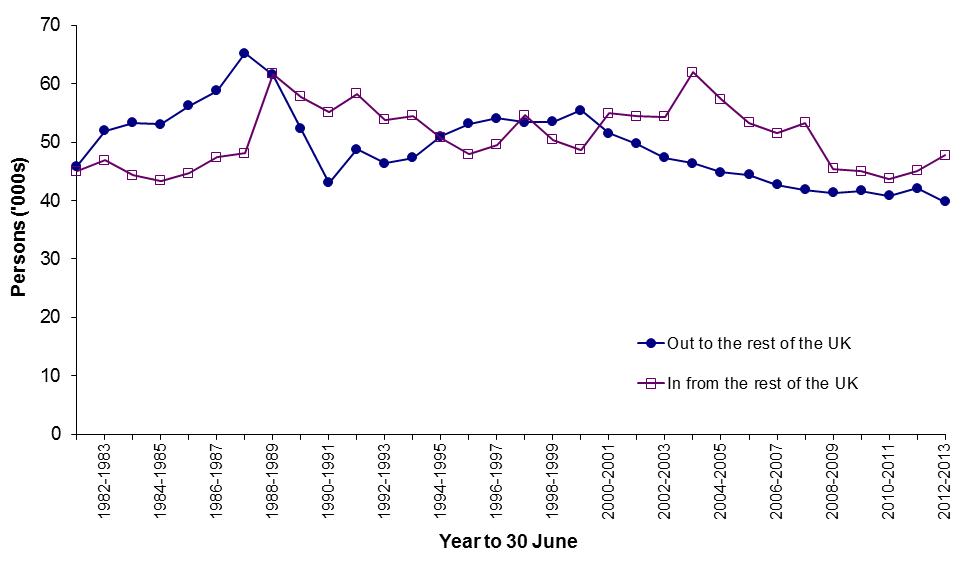
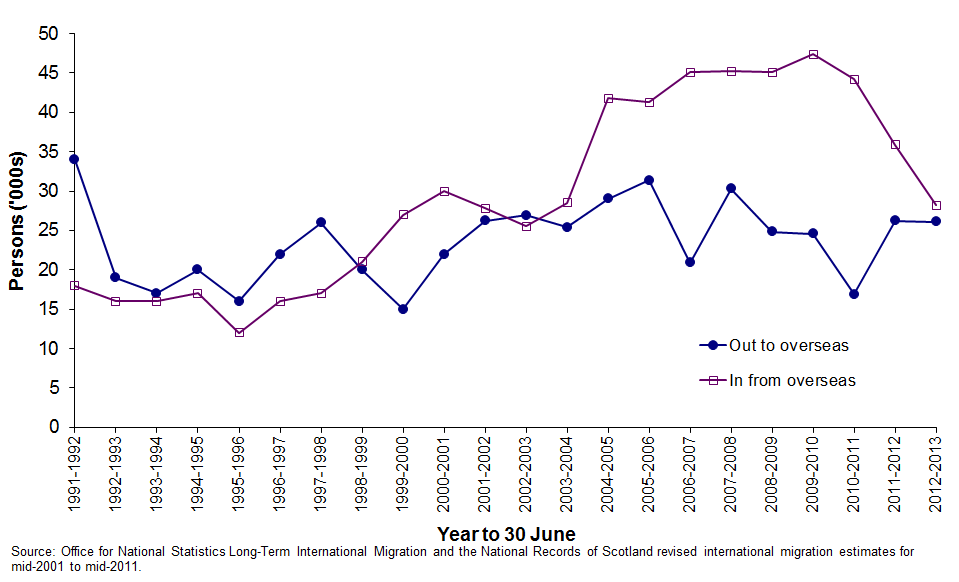
Table 5.1 summarises the migration flows between Scotland and the rest of UK and Scotland and overseas between mid-2012 and mid-2013. The in-flows and out-flows of migrants from overseas are relatively similar. However, the in-flows from the rest of the UK are larger than the out-flows to the rest of the UK. As a result, the largest component of the total net migration for this latest year is migration from rest of the UK migration.
| In | Out | Net | |
|---|---|---|---|
| Rest of UK | 47700 | 39800 | 7900 |
| Overseas | 28200 | 26100 | 2100 |
| Total | 75900 | 65900 | 10000 |
Figure 5.4 illustrates the ages of people moving between Scotland and the rest of the UK between mid-2012 and mid-2013. The peak age for migration into Scotland is 19, at which age there is a marked migration gain. The peak ages for migrating out of Scotland are 23 and 24 and this results in a migration loss at these ages. These large in- and out-flows result from an influx of students from outside Scotland starting higher education, followed by a move out of Scotland after graduation.
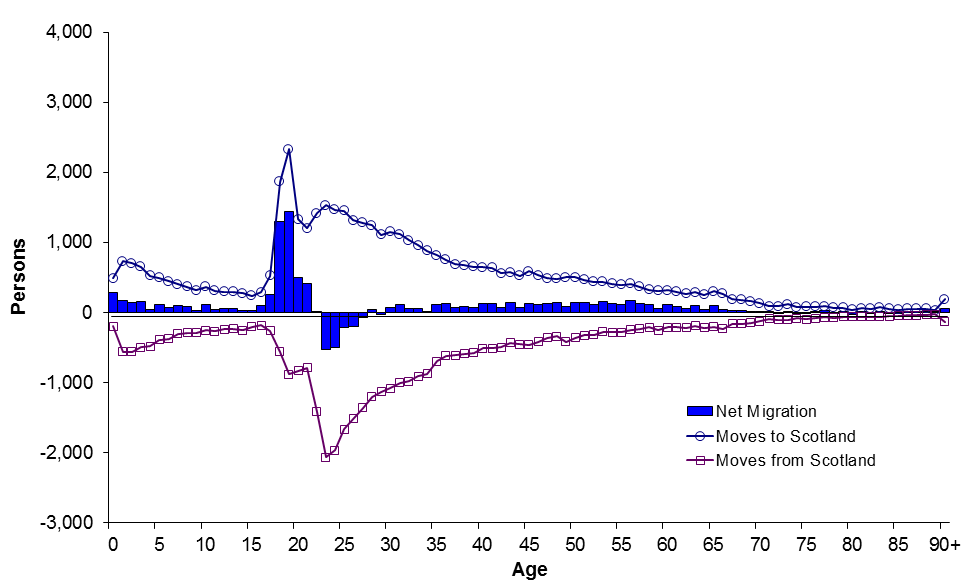
Figure 5.5 shows the age distribution of people moving between Scotland and overseas between mid-2012 and mid-2013. In contrast to moves to Scotland from the rest of the UK, the peak ages for migration into Scotland are 22 and 23. There are also high numbers of migrants (500 or more) from age 18 to 33. The peak age for migration out of Scotland to overseas is 24 and there are high numbers of out-migrants (500 or more) from age 20 to 34. This results in a net migration gain through to age 24 followed by a net loss at most older ages.
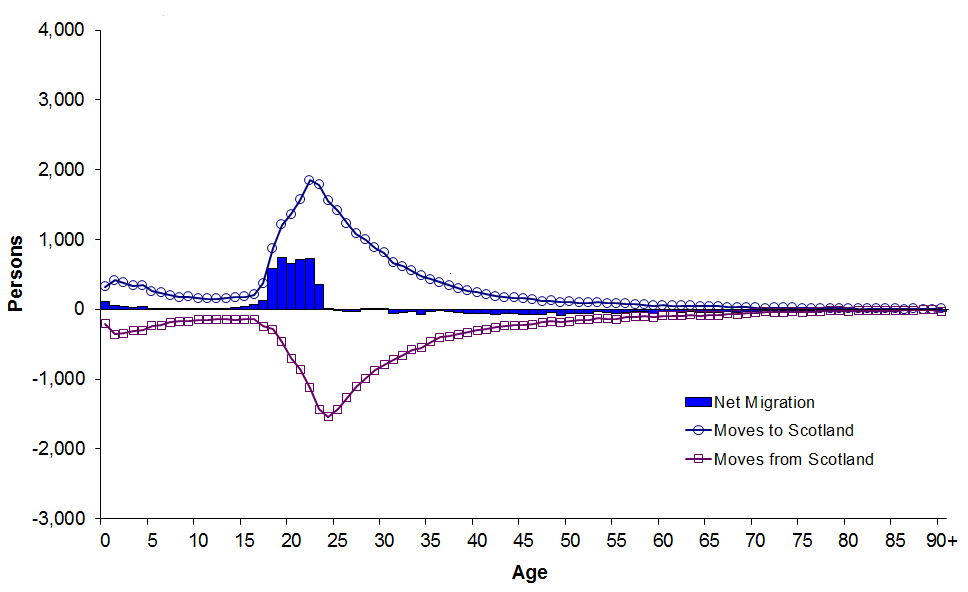
Migrants to and from the UK and overseas alike tend to be much younger than the general population: 50 per cent of in-migrants from the rest of the UK and 69 per cent of those from overseas are aged 16-34, compared with 25 per cent of the resident population. There also tend to be smaller peaks for moves of the very young, under the age of five, as their parents move home before their children have started school. Later in life, there is no significant 'retirement migration' in either direction. The pattern of migration is very similar for males and females.
In many parts of Scotland, migration is the most important component of population change. Net migration rates (here, the amount of net migration between mid-2012 and mid-2013 as a proportion of the mid-2012 population) are a useful indicator when comparing migration between areas of different sizes. Information on net rates for council areas, which includes migration between council areas, the rest of the UK and overseas, is shown in Figure 5.6.
The patterns of migration over the period since mid-2012 indicate that the highest net outmigration rates were in West Dunbartonshire, Shetland Islands and North Ayrshire. The highest net in-migration rates were in Aberdeen City, Midlothian and Moray. Migration between Scotland and the rest of UK and overseas shows a slightly different pattern. Migration in the period mid-2012 to mid-2013 to and from areas outside Scotland, as a proportion of the mid-2012 population, is shown in Figure 5.7. The highest net in-migration rates were in Aberdeen City, the City of Edinburgh and Moray. The highest net outmigration rates were in East Dunbartonshire, East Renfrewshire and Renfrewshire.
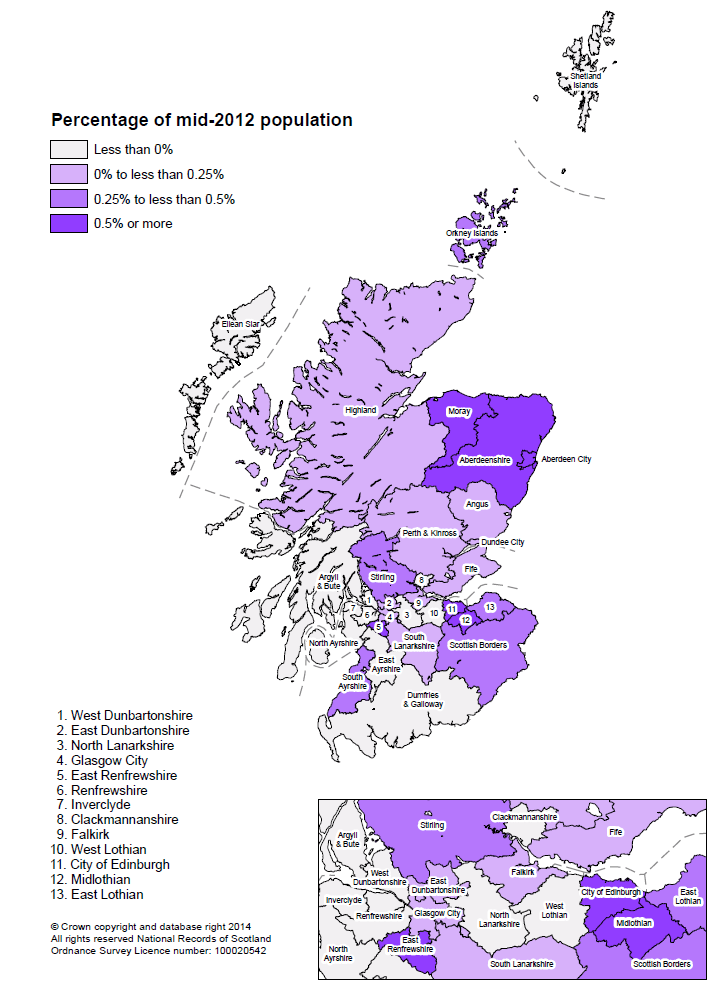
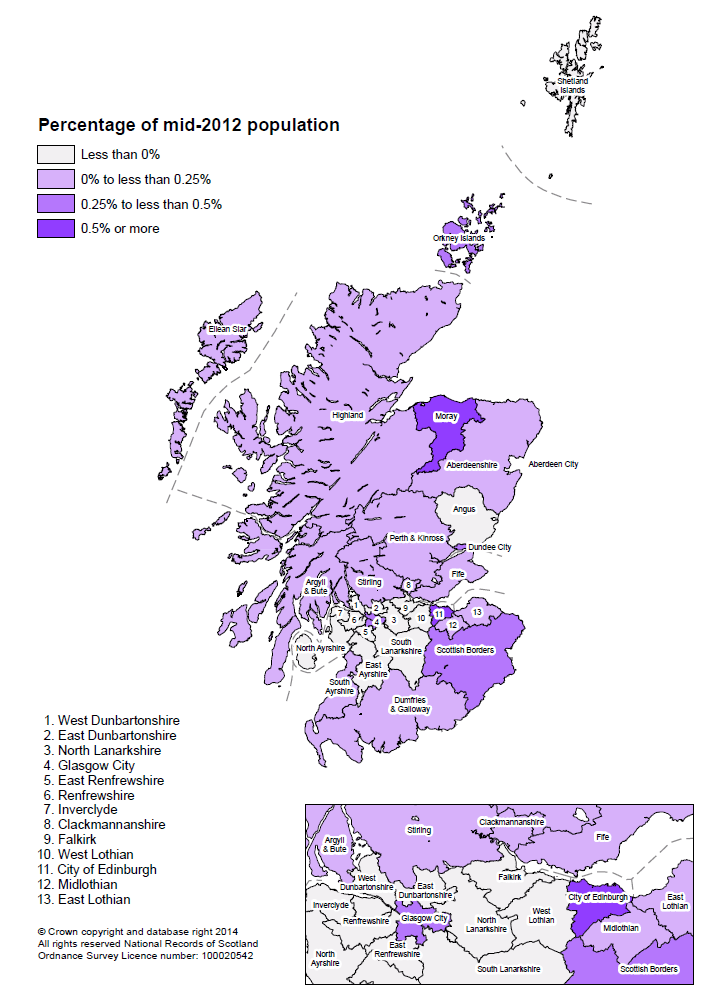
The 2011 Census provides us with a wealth of information about the characteristics of Scotland's population. Scotland's population on Census Day 2011 was estimated to be 5,295,403 an increase of 233,400 (5 per cent) since 2001. Some findings which shed light on the impact of migration on Scotland's population have been presented here. More detailed information on other characteristics can be found on the Scotland's Census website: www.scotlandscensus.gov.uk.
Ninety-three per cent of the people in Scotland stated they were born within the UK, a decrease of three percentage points since 2001. Eighty-three per cent of the population were born in Scotland, 9 per cent in England, 0.7 per cent in Northern Ireland and 0.3 per cent in Wales. Of the 7 per cent (369,000) of people in Scotland who were not born in the UK, 15 per cent (55,000) were born in Poland, and 6 per cent (23,000) were born in each of India and the Republic of Ireland. Every council area of Scotland saw an increase between 2001 and 2011 in the proportion of their population who were born outside the UK as shown in Figure 5.8.
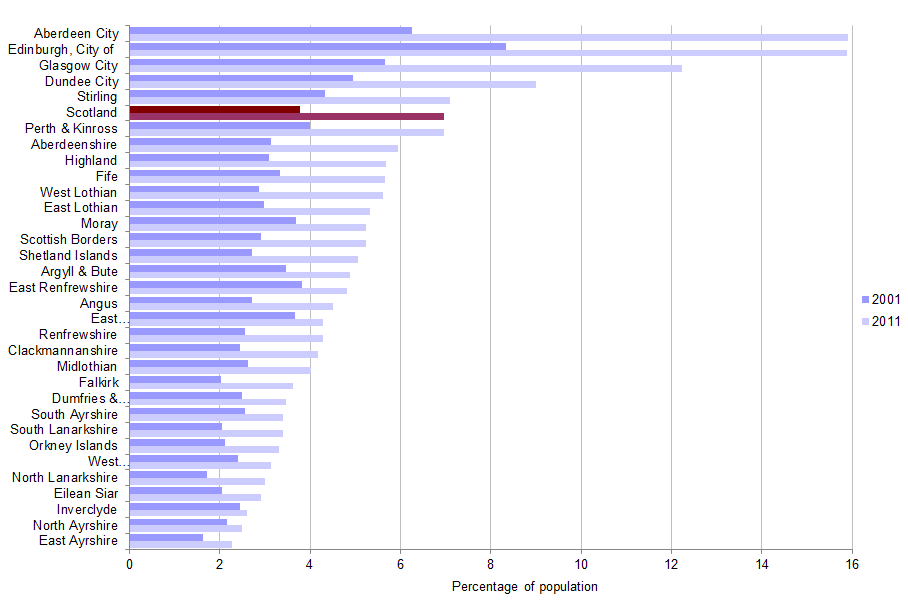
Over two-thirds (69 per cent) of people living in Scotland who were born abroad were of working age (16 to 64 years old) when they arrived in the UK. Over half (55 per cent) of people living in Scotland who were born abroad arrived in the UK between 2004 and March 2011.
Four per cent of people in Scotland were from minority ethnic groups1 - an increase of two percentage points since 2001. The Asian population was the largest minority ethnic group (3 per cent of the total population or 141,000 people) and has seen an increase of one percentage point (69,000) since 2001. Just over 1 per cent (1.2 per cent or 61,000) of the population recorded their ethnic group as White: Polish. This proportion was highest in the City of Edinburgh and Aberdeen City at 3 per cent of their total populations.
A 'White: Gypsy / Traveller' response category was added in 2011. There were 4,200 people who recorded their ethnic group in this category (0.1 per cent of all people in Scotland). The highest number was in Perth & Kinross (400 people; 0.3 per cent of the total population of that area). In Glasgow City, 12 per cent of the population were from a minority ethnic group, in City of Edinburgh and Aberdeen City it was 8 per cent and in Dundee City it was 6 per cent. These areas also saw the largest increases since 2001 in the proportion of their population who are from minority ethnic groups.
Since the early 2000s, and especially since Eastern European Countries joined the European Union (EU) in May 2004, migration has played a larger part in Scotland's demographic change than in the previous decade. So it has become more important to have high quality statistics on migration and the population, for policy development and for planning and providing public services. National Records of Scotland (NRS) was part of an inter-departmental effort, led by the Office for National Statistics (ONS), to improve the estimates of migration and migrant populations in the UK, both nationally and at a local level. More information on the Migration Statistics Improvement programme including the programme's final report is available on the ONS website.
The new information provided by the 2011 Census, as well as revising our population estimates for mid-2002 to mid-2011, has allowed us to review our methodology and make improvements to elements of the rolling-forward process. Further analysis of census data, particularly relating to migration, and continuing work to incorporate new data sources (for example student data from Higher Education Statistics Authority), will help us to improve our methods and be confident that we continue to capture population change into the next decade and beyond.
More detailed information about Scotland's migration can be found in the Migration section of the NRS website.
Footnotes: